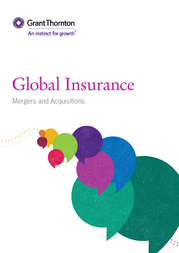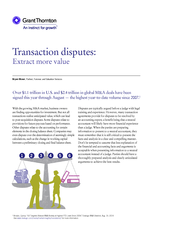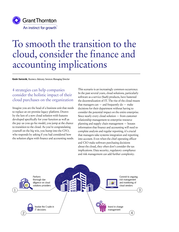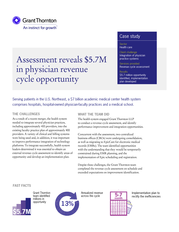Description
Meet risk challenges through leadership, collaboration
For example, procedures related to high-alert
medications — these are drugs that can cause
significant patient harm if administered incorrectly.
A nurse obtains a drug and determines if it is on the
hospital’s high-alert medication list. If it is listed,
policy likely requires an independent double-check
by the nurse prior to administration to the patient.
This would mean the medication must pass an
additional level of scrutiny before it is administered.
In a clinically oriented audit, IA can assist leadership
with education, analytics and process mapping. For
example, IA could help the chief nursing officer
determine whether nurses understand the difference
between a double-check and an independent doublecheck. Without having to understand the medical
aspects of the process, IA can provide substantive
value in the assessment of processes that support
clinical care.
An example from the operating room would be a
checklist or procedure for minimizing the likelihood
of a retained foreign object (RFO), such as a sponge
left in a person’s body.
In an RFO event, the surgeon may be subject to a probationary period of 90 to 120 days intended to reinforce procedures and controls to prevent RFOs. IA is not equipped to question a surgeon’s ability or the process for performing a medical procedure, but can review documentation and nonmedical processes put in place as part of the probationary and post-probationary periods. In this way, IA can ensure that medical leadership’s expectations are met and procedures to control RFOs are followed. Contacts Anne McGeorge National Managing Partner Health Care T +1 704 632 3520 E anne.mcgeorge@us.gt.com Victor Blanchard Director Business Advisory Services T +1 410 244 3210 E victor.blanchard@us.gt.com John Summerlin Senior Manager Health Care Advisory Services T +1 404 475 0188 E john.summerlin@us.gt.com As for every other function and process in the organization, the point is to assure a quality result — one that was agreed upon and planned for from the start. IA’s ability to collaborate, along with its unique perspective, will be a critical tool in successfully managing the transformation occurring in health care today. Contact us to learn more about how we can help your organization manage its risk. About the newsletter HealthCareRx is published by Grant Thornton LLP.
Founded in Chicago in 1924, Grant Thornton LLP (Grant Thornton) is the U.S. member firm of Grant Thornton International Ltd, one of the world’s leading organizations of independent audit, tax and advisory firms. In the United States, Grant Thornton has revenue in excess of $1.3 billion and operates 57 offices with more than 500 partners and 6,000 employees.
Grant Thornton works with a broad range of dynamic publicly and privately held companies, government agencies, financial institutions, and civic and religious organizations. This content is not intended to answer specific questions or suggest suitability of action in a particular case. For additional information about the issues discussed, contact a Grant Thornton LLP professional. Connect with us grantthornton.com @grantthorntonus linkd.in/grantthorntonus “Grant Thornton” refers to Grant Thornton LLP, the U.S. member firm of Grant Thornton International Ltd (GTIL), and/or refers to the brand under which the GTIL member firms provide audit, tax and advisory services to their clients, as the context requires.
GTIL and each of its member firms are separate legal entities and are not a worldwide partnership. GTIL does not provide services to clients. Services are delivered by the member firms in their respective countries.
GTIL and its member firms are not agents of, and do not obligate, one another and are not liable for one another’s acts or omissions. In the United States, visit grantthornton.com for details. © 2016 Grant Thornton LLP  |  All rights reserved  |  U.S. member firm of Grant Thornton International Ltd .
In an RFO event, the surgeon may be subject to a probationary period of 90 to 120 days intended to reinforce procedures and controls to prevent RFOs. IA is not equipped to question a surgeon’s ability or the process for performing a medical procedure, but can review documentation and nonmedical processes put in place as part of the probationary and post-probationary periods. In this way, IA can ensure that medical leadership’s expectations are met and procedures to control RFOs are followed. Contacts Anne McGeorge National Managing Partner Health Care T +1 704 632 3520 E anne.mcgeorge@us.gt.com Victor Blanchard Director Business Advisory Services T +1 410 244 3210 E victor.blanchard@us.gt.com John Summerlin Senior Manager Health Care Advisory Services T +1 404 475 0188 E john.summerlin@us.gt.com As for every other function and process in the organization, the point is to assure a quality result — one that was agreed upon and planned for from the start. IA’s ability to collaborate, along with its unique perspective, will be a critical tool in successfully managing the transformation occurring in health care today. Contact us to learn more about how we can help your organization manage its risk. About the newsletter HealthCareRx is published by Grant Thornton LLP.
Founded in Chicago in 1924, Grant Thornton LLP (Grant Thornton) is the U.S. member firm of Grant Thornton International Ltd, one of the world’s leading organizations of independent audit, tax and advisory firms. In the United States, Grant Thornton has revenue in excess of $1.3 billion and operates 57 offices with more than 500 partners and 6,000 employees.
Grant Thornton works with a broad range of dynamic publicly and privately held companies, government agencies, financial institutions, and civic and religious organizations. This content is not intended to answer specific questions or suggest suitability of action in a particular case. For additional information about the issues discussed, contact a Grant Thornton LLP professional. Connect with us grantthornton.com @grantthorntonus linkd.in/grantthorntonus “Grant Thornton” refers to Grant Thornton LLP, the U.S. member firm of Grant Thornton International Ltd (GTIL), and/or refers to the brand under which the GTIL member firms provide audit, tax and advisory services to their clients, as the context requires.
GTIL and each of its member firms are separate legal entities and are not a worldwide partnership. GTIL does not provide services to clients. Services are delivered by the member firms in their respective countries.
GTIL and its member firms are not agents of, and do not obligate, one another and are not liable for one another’s acts or omissions. In the United States, visit grantthornton.com for details. © 2016 Grant Thornton LLP  |  All rights reserved  |  U.S. member firm of Grant Thornton International Ltd .
Investor Relations Presentations
+
Investor Relations Sub Categories














